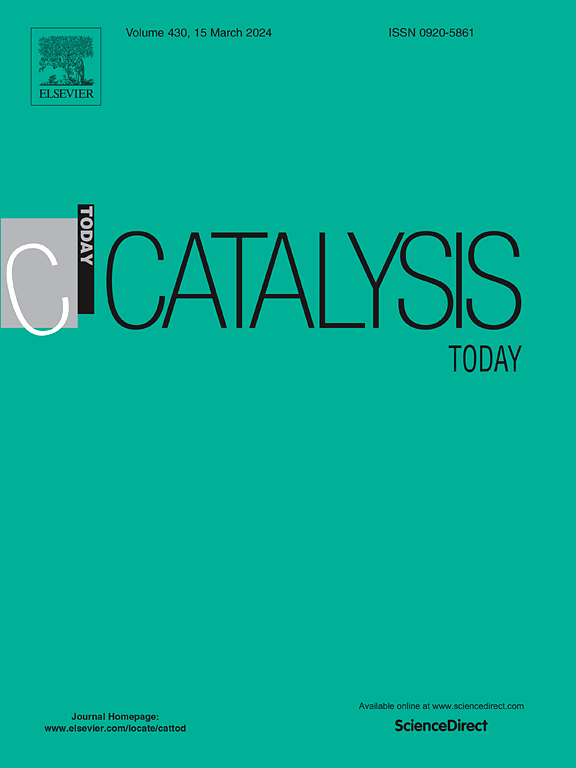揭示Cu/ZSM-5催化剂中选择性催化氧化氨的活性Cu组分
IF 5.2
2区 化学
Q1 CHEMISTRY, APPLIED
引用次数: 0
摘要
氨滑是NH₃过程的副产品,会对环境和健康造成重大风险,因此需要通过氨的选择性催化氧化(NH₃-SCO)来去除氨滑。在本研究中,通过离子交换合成了一系列不同Cu负载的Cu/ZSM-5催化剂,其中2.1Cu/ZSM-5催化剂在400℃下的NH₃转化率高达99.5 %,N₂选择性高达99.4 %。为了研究NH3-SCO反应中的活性Cu位点,利用H2-TPR和EPR分析,定量分析了Cu的种类分布与反应速率的相关性,结果表明,分离Cu2+离子表现出最强的线性相关性。Cu2+选择性还原为Cu+的对照实验导致NH3转化率显著降低,证实了在NH3- sco反应中Cu2+离子比Cu+离子更活跃。基于Cu2+离子数量计算的周转频率(TOF)几乎保持不变,在Cu负载较高时略有增加,证实了Cu2+离子在催化氧化过程中的主要作用,其他Cu物种的贡献较小。进一步的NH₃-TPD和原位DRIFTS分析表明,Cu离子交换提供了更高的NH3吸附能力,潜在地提高了NH₃-SCO催化剂的活性。这些发现为开发更有效的Cu/沸石催化剂在工业应用中去除NH₃提供了有价值的见解。本文章由计算机程序翻译,如有差异,请以英文原文为准。
Revealing the active Cu species in Cu/ZSM-5 catalysts for the selective catalytic oxidation of ammonia
Ammonia slip, a by-product of NH₃ processes, poses significant environmental and health risks, necessitating its removal via the selective catalytic oxidation of ammonia (NH₃-SCO). In this study, a series of Cu/ZSM-5 catalysts with varying Cu loadings was synthesized via ion-exchange, where the 2.1Cu/ZSM-5 catalyst achieved up to 99.5 % NH₃ conversion and 99.4 % N₂ selectivity at 400 °C. To investigate the active Cu sites in the NH3-SCO reaction, the distribution of the Cu species, quantified using H2-TPR and EPR analyses, was correlated with the reaction rate, revealing that isolated Cu2+ ions exhibited the strongest linear correlation. A controlled experiment involving the selective reduction of Cu2+ to Cu+ resulted in a significant decrease in the NH3 conversion, confirming that Cu2+ ions are more active than Cu+ ions in the NH3-SCO reaction. The turnover frequency (TOF) calculated based on the number of Cu2+ ions remained nearly constant, with a slight increase at higher Cu loadings, confirming the primary role of Cu2+ ions in the catalytic oxidation process and the minor contributions of other Cu species. Further NH₃-TPD and in situ DRIFTS analyses demonstrated that Cu ion-exchange provides higher NH3 adsorption ability, potentially enhancing the activity of the catalysts for the NH₃-SCO. These findings offer valuable insights for developing more efficient Cu/zeolite catalysts for NH₃ removal in industrial applications.
求助全文
通过发布文献求助,成功后即可免费获取论文全文。
去求助
来源期刊

Catalysis Today
化学-工程:化工
CiteScore
11.50
自引率
3.80%
发文量
573
审稿时长
2.9 months
期刊介绍:
Catalysis Today focuses on the rapid publication of original invited papers devoted to currently important topics in catalysis and related subjects. The journal only publishes special issues (Proposing a Catalysis Today Special Issue), each of which is supervised by Guest Editors who recruit individual papers and oversee the peer review process. Catalysis Today offers researchers in the field of catalysis in-depth overviews of topical issues.
Both fundamental and applied aspects of catalysis are covered. Subjects such as catalysis of immobilized organometallic and biocatalytic systems are welcome. Subjects related to catalysis such as experimental techniques, adsorption, process technology, synthesis, in situ characterization, computational, theoretical modeling, imaging and others are included if there is a clear relationship to catalysis.
 求助内容:
求助内容: 应助结果提醒方式:
应助结果提醒方式:


